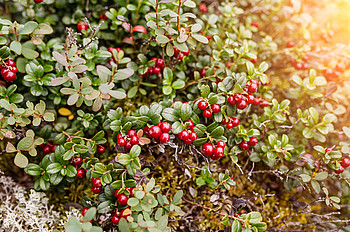Origin and botany

The botanical name of the cowberry is Vaccinium vitis-idaea - this already shows that it belongs to the genus of blueberries (Vaccinium). The cowberry is a heather plant that, as a compact, creeping bush, also looks very similar to the wild blueberry. The cowberry is native to the northern part of Eurasia. In the meantime, the ground cover can be found worldwide in temperate latitudes near coniferous forests, heaths and alpine regions. It also does not shy away from arctic regions such as Greenland. The leaves are evergreen, oval, shiny and have a leathery texture. The fruits are small, round and bright red and contain a light-coloured pulp with many seeds.
The difference between cowberry and cranberry
Although the cowberry is related to the cranberry (American cranberry), they are two different plants from the same family. Cowberry and cranberry differ in appearance as well as in the taste and growth habit of the plant. For example, cranberries are larger than cowberries and the cranberry bush climbs along the ground.
Cowberry: cultivation and harvest
In many regions, cowberries are harvested wild. In addition, there are certain cultivated varieties that have been bred for a higher yield than the wild original forms. The shrubs thrive in acidic, low-lime soils and are also suitable for cultivation in the garden in a semi-shaded location. The white or reddish blossoms of the cowberry appear around May or June - about six weeks later the pea-sized fruits emerge. The berries are white at first, but turn a deep red colour as they ripen. The cowberry is tough and can withstand temperatures as low as minus 20 degrees. Harvest time for cowberries is around June, depending on the region. Sometimes the plants bear fruit a second time in September or October.
The cowberry and its ingredients
The cowberry contains a whole range of valuable ingredients. In many of its northern home regions, it is therefore valued as an important natural source of vitamins. The high acid content of the fruit has a strong preservative effect and therefore ensures a long shelf life for cowberry products.
Cowberry processing
In principle, you can also eat cowberries raw. However, the fresh fruits taste very tart and often extremely sour. Therefore, they are usually not eaten raw, but processed in various forms:
- As compote, jelly or jam, the cowberry with its characteristic flavour is a much appreciated ingredient in the kitchen. It is typically added to schnitzel, game and poultry dishes as well as cheese.
- Dried cowberries are used in biscuits, cereals and muesli bars, for example.
- Pure juice from cowberries contains many of the valuable natural ingredients due to its gentle processing. Our Rabenhorst Cowberry juice is made from hand-picked wild fruits that are only pressed once to preserve the natural taste experience. The juice can either be drunk as pure juice from first pressing or used as a high-quality ingredient in cooking.
FAQ
Where does the cowberry grow?
The cowberry grows all over the world in regions with a temperate climate. For example, it can be found in Europe, Asia, North America and even the Arctic. However, it originates from the northern part of Eurasia.
What is the difference between cowberries, cranberries and blueberries?
Blueberries, cowberries and cranberries are the fruits of three different plants that differ greatly in appearance and taste. However, all three plants belong to the blueberry genus and the heather family.
Can you eat cowberries raw?
In principle, it is possible to consume cowberries raw, but the tart and extremely sour taste takes a lot of getting used to. We recommend consumption in the form of a high-quality pure juice or in cooked form as compote or jam.

